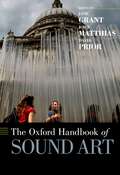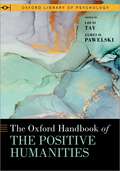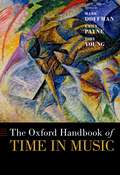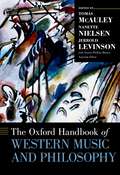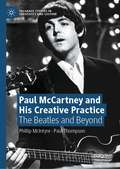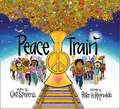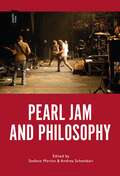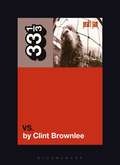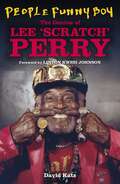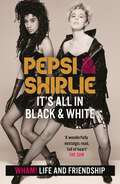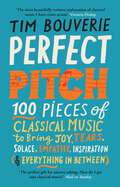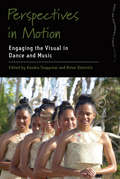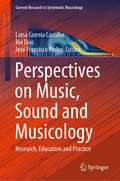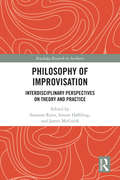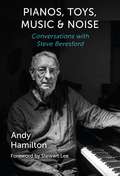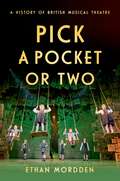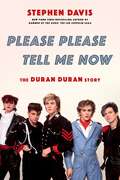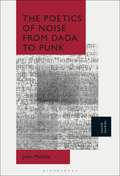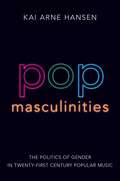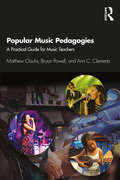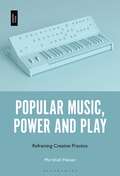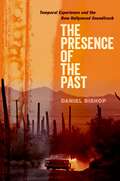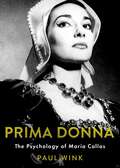- Table View
- List View
The Oxford Handbook of Sound Art (Oxford Handbooks)
by Jane Grant, John Matthias, David PriorSound art has long been resistant to its own definition. Emerging from a liminal space between movements of thought and practice in the twentieth century, sound art has often been described in terms of the things that it is understood to have left behind: a space between music, fine art, and performance. The Oxford Handbook of Sound Art surveys the practices, politics, and emerging frameworks of thought that now define this previously amorphous area of study. Throughout the Handbook, artists and thinkers explore the uses of sound in contemporary arts practice. Imbued with global perspectives, chapters are organized in six overarching themes of Space, Time, Things, Fabric, Senses and Relationality. Each theme represents a key area of development in the visual arts and music during the second half of the twentieth century from which sound art emerged. By offering a set of thematic frameworks through which to understand these themes, this Handbook situates constellations of disparate thought and practice into recognized centers of activity.
The Oxford Handbook of the Positive Humanities (Oxford Library of Psychology)
by Louis Tay, James O. PawelskiThis handbook examines the new and rapidly growing field of the positive humanities--an area of academic research at the intersection of positive psychology and the arts and humanities. Written by leading experts across a wide range of academic disciplines, the volume begins with an overview of the science and culture of human flourishing, covering historical and current trends in this literature. Next, contributors consider the well-being benefits of engagement with the arts and humanities, marking out neurological, cognitive, emotional, behavioral, and social pathways to human flourishing. These pathways lead to detailed investigations of individual fields within the arts and humanities, including music, the visual arts, philosophy, history, literature, religion, theater, and film. Along the way, the book thoroughly synthesizes theory, research, and exemplary practice, concluding with thought-provoking discussions of avenues for public engagement and policy. With its expansive coverage of both the field as a whole and specialized disciplinary and interdisciplinary drivers, The Oxford Handbook of the Positive Humanities advances the literature on the theory and science of well-being and extends the scope of the arts and humanities.
The Oxford Handbook of Time in Music (Oxford Handbooks)
by Mark Doffman, Emily Payne, Toby YoungMusic represents one of humanity's most vivid contemplations on the nature of time itself. The ways that music can modify, intensify, and even dismantle our understanding of time's passing is at the foundation of musical experience, and is common to listeners, composers, and performers alike. The Oxford Handbook of Time in Music provides a range of compelling new scholarship that examines the making of musical time, its effects and structures. Bringing together philosophical, psychological, and socio-cultural understandings of time in music, the chapters highlight the act of 'making' not just as cultural construction but also in terms of the perceptual, cognitive underpinnings that allow us to 'make' sense of time in music. Thus, the Handbook is a unique synthesis of divergent perspectives on the nature of time in music. With its focus on contemporary music (while paying attention to some of the generative temporalities of the nineteenth century), the volume establishes the richness and complexity of so much current music-making and in the process overcomes historic demarcations between art and popular musics.
The Oxford Handbook of Western Music and Philosophy (Oxford Handbooks)
by Ariana Phillips-HuttonWhether regarded as a perplexing object, a morally captivating force, an ineffable entity beyond language, or an inescapably embodied human practice, music has captured philosophically inclined minds since time immemorial. In turn, musicians of all stripes have called on philosophy as a source of inspiration and encouragement, and scholars of music through the ages have turned to philosophy for insight into music and into the worlds that sustain it. In this Handbook, contributors build on this legacy to conceptualize the rich interactions of Western music and philosophy as a series of meeting points between two vital spheres of human activity. They draw together key debates at the intersection of music studies and philosophy, offering a field-defining overview while also forging new paths. Chapters cover a wide range of musics and philosophies, including concert, popular, jazz, and electronic musics, and both analytic and continental philosophy.
Paul McCartney and His Creative Practice: The Beatles and Beyond (Palgrave Studies in Creativity and Culture)
by Phillip McIntyre Paul ThompsonThis book provides fresh insight into the creative practice developed by Paul McCartney over his extended career as a songwriter, record producer and performing musician. It frames its examination of McCartney’s work through the lens of the systems model of creativity developed by Mihaly Csikszentmihalyi and combines this with the research work of Pierre Bourdieu. This systems approach is built around the basic structures of idiosyncratic agents, like McCartney himself, and the choices he has made as a creative individual. It also locates his work within social fields and cultural domains, all crucial aspects of the creative system that McCartney continues to be immersed in. Using this tripartite system, the book includes analysis of McCartney’s creative collaborations with musicians, producers, artists and filmmakers and provides a critical analysis of the Romantic myth which forms a central tenet of popular music. This engaging work will have interdisciplinary appeal to students and scholars of the psychology of creativity, popular music, sociology and cultural studies.
Peace Train
by Cat StevensThe iconic song is now an incredible picture book! Celebrate fifty years of Cat Stevens’ timeless anthem with this joyfully illustrated picture book filled with hope, love, and the celebration of all cultures and identities.
Pearl Jam and Philosophy
by Andrea Schembari Stefano MarinoThe first scholarly discussion on the band, Pearl Jam and Philosophy examines both the songs (music and lyrics) and the activities (live performances, political commitments) of one of the most celebrated and charismatic rock bands of the last 30 years. The book investigates the philosophical aspects of their music at various levels: existential, spiritual, ethical, political, metaphysical and aesthetic. This philosophical interpretation is also dependent on the application of textual and poetic analysis: the interdisciplinary volume puts philosophical aspects of the band's lyrics in close dialogue with 19th- and 20th-century European and American poetry. Through this widespread philosophical examination, the book further looks into the band's immense popularity and commercial success, their deeply loyal fanbase and genuine sense of community surrounding their music, and the pivotal place the band holds within popular music and contemporary culture.
Pearl Jam's Vs. (33 1/3 #154)
by Clint BrownleeVs. is the sound of a band on fire. The same confluence of talent, passion, timing, and fate that made “grunge” the world's soundtrack also lit a short fuse beneath Pearl Jam. The band combusted between late 1992 and mid-1994, the span during which they planned, recorded, and supported their sophomore record. The spotlight, the pressure, the pace-it all nearly turned the thriving act to ash.Eddie Vedder, the reluctant public face of the band, responded by lashing out lyrically. Jeff Ament, Mike McCready, and Stone Gossard, who beheld success with varying degrees of anxious satisfaction, attacked their instruments in solidarity. Dave Abbruzzese welcomed the rock-star lifestyle, and left his mark on the record with more than just potent percussion.Vs. roils with fury-and at times, gently steams-over the trappings of fame, human faults, and societal injustice. The record is a thrashing testament to Pearl Jam's urgent creativity and greater-good interests, and the band's logistical calculations behind it drew a career-defining line in the sand. It promised the world that Pearl Jam would neither burn out nor fade away. This book weaves research, little-known details, and band members' memories into a definitive account of how Vs. set them on a path toward enduring integrity and relevance.
People Funny Boy: The Genius of Lee 'Scratch' Perry
by David Katz'David Katz's in-depth portrayal of his genius is to be commended and is an essential addition to any serious music fan's collection' David Rodigan MBE OD'For the complete picture of this musical genius you can't get better than David Katz's People Funny Boy - if you're into Scratch, it's essential' Don LettsArguably the most influential force in Jamaican music, Lee Perry brought Bob Marley to international stardom and has since collaborated with artists such as Sir Paul McCartney, The Clash and The Beastie Boys. The book delves behind the myth of Perry to give a fuller examination of his life and work through extensive interviews with family members, fellow artists, friends, lovers, enemies, as well as the man himself to present a complex portrait of a unique soul driven by unseen spiritual forces. This revised and expanded edition has been thoroughly updated and completely overhauled to render a more nuanced, accurate and accessible read, with new information on Perry's later years, including his Grammy Award, cessation of herb smoking and final passing, as well as previously unpublished information about his early life, his unique relationship with Marley, and his fabled Black Ark studio.
Pepsi & Shirlie - It's All in Black and White: Wham! Life and Friendship
by Pepsi Demacque-Crockett Shirlie KempLondon. Wham! Pop, glitz and glamour. And two girls with stars in their eyes.Our friendship began one windy day in 1982, outside Finsbury Park tube. It was an instant like at first sight. We were on our way to a Wham! rehearsal. Pepsi was the new girl in the band and over a car stereo, a cassette tape and that journey to Bushey we bonded. We had no idea that we were on the first of many journeys together and that soon we'd be travelling all over Europe, Australia, America, China and Japan. Or that no matter where we went, together, we'd find a way to make every exotic destination feel like home.We'd both been teenagers during the seventies – a dreary and difficult decade, especially if you were young in London and you didn't have much money.So, in 1982, anything was possible for us – a pair of twentysomethings who hadn't been to university, who didn't have any money, who dreamt of singing and dancing, but ultimately lived for fun. Everything felt new and life was a question mark. We had no idea what was lying ahead, but we wanted to say yes.What we didn't know was that we were saying yes to a lifetime of connection that has endured whatever we've done, wherever we've been. From the side of the stage to its centre – we have many stories to tell.And it's all here, it's all in black and white.
Perfect Pitch: 100 pieces of classical music to bring joy, tears, solace, empathy, inspiration (& everything in between)
by Tim Bouverie'Sharply insightful and vividly imaginative... the perfect Christmas gift for anyone asking: 'How do I get into classical music?'' - Rupert Christiansen, Mail on Sunday'A treat from the very first page... written with style and humour, this is a perfect introduction to classical music for a beginner, a companion for the music lover, and sheer entertainment for both.' - Joanna LumleyNearly all of us have the capacity to enjoy classical music but too often we are put off by not knowing where to look, or what we are actually looking for. We feel the need of a guide to help navigate such vast and varied artistic terrain.With this delightful book, historian Tim Bouverie provides just this. Drawing on his lifelong passion for music, he has created a compilation of 100 classical masterpieces sure to move and be enjoyed by almost anyone. Some are well-known, some more idiosyncratic, others hidden gems waiting to be brought into the light. All are intended to comfort and inspire. He provides a short introduction to each piece - variously anecdotal, personal, historical and quirky - and a recommended recording to try.Highly accessible and entertaining, Perfect Pitch is filled with engrossing stories and insights that bring to life 300 years of the world's greatest music.An accompanying playlist is available on Spotify.
Perspectives in Motion: Engaging the Visual in Dance and Music (Dance and Performance Studies #15)
by Kendra Stepputat Brian DiettrichFocusing on visual approaches to performance in global cultural contexts, Perspectives in Motion explores the work of Adrienne L. Kaeppler, a pioneering researcher who has made a number of interdisciplinary contributions over five decades to dance and performance studies. Through a diverse range of case studies from Oceania, Asia, and Europe, and interdisciplinary approaches, this edited collection offers new critical and ethnographic frameworks for understanding and experiencing practices of music and dance across the globe.
Perspectives on Music, Sound and Musicology: Research, Education and Practice (Current Research in Systematic Musicology #10)
by Luísa Correia Castilho Rui Dias José Francisco PinhoThis book gathers a set of works highlighting significant advances in the areas of music and sound. They report on innovative music technologies, acoustics, findings in musicology, new perspectives and techniques for composition, sound design and sound synthesis, and methods for music education and therapy. Further, they cover interesting topics at the intersection between music and computing, design and social sciences. Chapters are based on extended and revised versions of the best papers presented during the 6th and 7th editions of EIMAD–Meeting of Research in Music, Arts and Design, held in 2020 and 2021, respectively, at the School of Applied Arts in Castelo Branco, Portugal. All in all, this book provides music researchers, educators and professionals with authoritative information about new trends and techniques, and a source of inspiration for future research, practical developments, and for establishing collaboration between experts from different fields.
Philosophy of Improvisation: Interdisciplinary Perspectives on Theory and Practice (Routledge Research in Aesthetics)
by Susanne Ravn Simon Høffding James McGuirkThis volume brings together philosophical and interdisciplinary perspectives on improvisation. The contributions connect the theoretical dimensions of improvisation with different viewpoints on its practice in the arts and the classroom. The chapters address the phenomenon of improvisation in two related ways. On the one hand, they attend to the lived practices of improvisation both within and without the arts in order to explain the phenomenon. They also extend the scope of improvisational practices to include the role of improvisation in habit and in planned action, at both individual and collective levels. Drawing on recent work done in the philosophy of mind, they address questions such as whether improvisation is a single unified phenomenon or whether it entails different senses that can be discerned theoretically and practically. Finally, they ask after the special kind of improvisational expertise which characterizes musicians, dancers, and other practitioners, an expertise marked by the artist’s ability to participate competently in complex situations while deliberately relinquishing control. Philosophy of Improvisation will appeal to anyone with a strong interest in improvisation, to researchers working in philosophy, aesthetics, and pedagogy as well as practitioners involved in different kinds of music, dance, and theater performances.
Philosophy of Improvisation: Interdisciplinary Perspectives on Theory and Practice (Routledge Research in Aesthetics)
by Susanne Ravn; Simon Høffding; James McGuirkThis volume brings together philosophical and interdisciplinary perspectives on improvisation. The contributions connect the theoretical dimensions of improvisation with different viewpoints on its practice in the arts and the classroom. The chapters address the phenomenon of improvisation in two related ways. On the one hand, they attend to the lived practices of improvisation both within and without the arts in order to explain the phenomenon. They also extend the scope of improvisational practices to include the role of improvisation in habit and in planned action, at both individual and collective levels. Drawing on recent work done in the philosophy of mind, they address questions such as whether improvisation is a single unified phenomenon or whether it entails different senses that can be discerned theoretically and practically. Finally, they ask after the special kind of improvisational expertise which characterizes musicians, dancers, and other practitioners, an expertise marked by the artist’s ability to participate competently in complex situations while deliberately relinquishing control. Philosophy of Improvisation will appeal to anyone with a strong interest in improvisation, to researchers working in philosophy, aesthetics, and pedagogy as well as practitioners involved in different kinds of music, dance, and theater performances.
Pianos, Toys, Music and Noise: Conversations with Steve Beresford
by Andy HamiltonSteve Beresford's polymathic activities have formed a prism for the UK improv scene since the 1970s. He is internationally known as a free improviser on piano, toy piano and electronics, composer for film and TV, and raconteur and Dadaist visionary. His résumé is filled with collaborations with hundreds of musicians and other artists, including such leading improvisers as Derek Bailey, Evan Parker and John Zorn, and he has given performances of works by John Cage and Christian Marclay. In this book, Beresford is heard in his own words through first-hand interviews with the author. Beresford provides compelling insight into an extensive range of topics, displaying the broad cultural context in which music is embedded. The volume combines chronological and thematic chapters, with topics covering improvisation and composition in jazz and free music; the connections between art, entertainment and popular culture; the audience for free improvisation; writing music for films; recording improvised music in the studio; and teaching improvisation. It places Beresford in the context of improvised and related musics – jazz, free jazz, free improvisation – in which there is growing interest.
Pick a Pocket Or Two: A History of British Musical Theatre
by Ethan MorddenFrom Gilbert and Sullivan to Andrew Lloyd Webber, from Julie Andrews to Hugh Jackman, from Half a Sixpence to Matilda, Pick a Pocket Or Two is the story of the British musical: where it began and how it developed. In Pick a Pocket Or Two, acclaimed author Ethan Mordden brings his wit and wisdom to bear in telling the full history of the British musical, from The Beggar's Opera (1728) to the present, with an interest in isolating the unique qualities of the form and its influence on the American model. To place a very broad generalization, the American musical is regarded as largely about ambition fulfilled, whereas the British musical is about social order. Oklahoma!'s Curly wins the heart of the farmer Laurey--or, in other words, the cowboy becomes a landowner, establishing a truce between the freelancers on horseback and the ruling class. Half a Sixpence, on the other hand, finds a working-class boy coming into a fortune and losing it to fancy Dans, whereupon he is reunited with his working-class sweetheart, his modest place in the social order affirmed. Anecdotal and evincing a strong point of view, the book covers not only the shows and their authors but the personalities as well--W. S. Gilbert trying out his stagings on a toy theatre, Ivor Novello going to jail for abusing wartime gas rationing during World War II, fabled producer C. B. Cochran coming to a most shocking demise for a man whose very name meant "classy, carefree entertainment." Unabashedly opinionated and an excellent stylist, author Ethan Mordden provokes as much as he pleases. Mordden is the preeminent historian of the form, and his book will be required reading for readers of all walks, from the most casual of musical theater goers to musical theater buffs to students and scholars of the form.
Please Please Tell Me Now: The Duran Duran Story
by Stephen DavisLifelong fans and interested newcomers will love this stunning biography of Duran Duran by the best-selling author of Gold Dust Woman and Hammer of the Gods. In Please Please Tell Me Now, best-selling rock biographer Stephen Davis tells the story of Duran Duran, the quintessential band of the 1980s. Their pretty boy looks made them the stars of fledgling MTV, but it was their brilliant musicianship that led to a string of number one hits. By the end of the decade, they had sold 60 million albums; today, they've sold over 100 million albums - and counting. Davis traces their roots to the austere 1970s British malaise that spawned both the Sex Pistols and Duran Duran - two seemingly opposite music extremes. Handsome, British, and young, it was Duran Duran that headlined Live Aid, not Bob Dylan or Led Zeppelin. The band moved in the most glamorous circles: Nick Rhodes became close with Andy Warhol, Simon LeBon with Princess Diana, and John Taylor dated quintessential British bad girl Amanda De Cadanet. With timeless hits like "Hungry Like the Wolf", "Girls on Film", "Rio", "Save a Prayer", and the best-selling James Bond theme in the series' history, "A View to Kill", Duran Duran has cemented its legacy in the pop pantheon - and with a new album and a worldwide tour on the way, they show no signs of slowing down anytime soon. Featuring exclusive interviews with the band, Please Please Tell Me Now offers a definitive account of one of the last untold sagas in rock and roll history - a treat for diehard fans, new admirers, and music lovers of any age.
The Poetics of Noise from Dada to Punk
by John MelilloBy reinterpreting 20th-century poetry as a listening to and writing through noise, The Poetics of Noise from Dada to Punk constructs a literary history of noise through poetic sound and performance. This book traces how poets figure noise in the disfiguration of poetic voice. Materializing in the threshold between the heard and the unheard, noise emerges in the differentiation and otherness of sound. It arises in the folding of an “outside” into the “inside” of poetic performance both on and off the page. Through a series of case studies ranging from verse by ear-witnesses to the First World War, Dadaist provocations, jazz modernist song and poetry, early New York City punk rock, contemporary sound poetry, and noise music, The Poetics of Noise from Dada to Punk describes productive failures of communication that theorize listening against the grain of sound's sense.
Pop Masculinities: The Politics of Gender in Twenty-First Century Popular Music
by Kai Arne HansenIn Pop Masculinities, author Kai Arne Hansen investigates the performance and policing of masculinity in pop music as a starting point for grasping the broad complexity of gender and its politics in the early twenty-first century. Drawing together perspectives from critical musicology, gender studies, and adjacent scholarly fields, the book presents extended case studies of five well-known artists: Zayn, Lil Nas X, Justin Bieber, The Weeknd, and Take That. By directing particular attention to the ambiguities and contradictions that arise from these artists' representations of masculinity, Hansen argues that pop performances tend to operate in ways that simultaneously reinforce and challenge gender norms and social inequalities. Providing a rich exploration of these murky waters, Hansen merges the interpretation of recorded song and music video with discourse analysis and media ethnography in order to engage with the full range of pop artists' public identities as they emerge at the intersections between processes of performance, promotion, and reception. In so doing, he advances our understanding of the aesthetic and discursive underpinnings of gender politics in twenty-first century pop culture and encourages readers to contemplate the sociopolitical implications of their own musical engagements as audiences, critics, musicians, and scholars.
Popular Music Pedagogies: A Practical Guide for Music Teachers
by Matthew Clauhs Bryan Powell Ann C. ClementsPopular Music Pedagogies: A Practical Guide for Music Teachers provides readers with a solid foundation of playing and teaching a variety of instruments and technologies, and then examines how these elements work together in a comprehensive school music program. With individual chapters designed to stand independently, instructors can adapt this guide to a range of learning abilities and teaching situations by combining the pedagogies and methodologies presented. This textbook is an ideal resource for preservice music educators enrolled in popular music education, modern band, or secondary general methods coursework and K-12 music teachers who wish to create or expand popular music programs in their schools. The website includes play-alongs, video demonstrations, printed materials, and links to useful popular music pedagogy resources.
Popular Music Pedagogies: A Practical Guide for Music Teachers
by Matthew Clauhs Bryan Powell Ann C. ClementsPopular Music Pedagogies: A Practical Guide for Music Teachers provides readers with a solid foundation of playing and teaching a variety of instruments and technologies, and then examines how these elements work together in a comprehensive school music program. With individual chapters designed to stand independently, instructors can adapt this guide to a range of learning abilities and teaching situations by combining the pedagogies and methodologies presented. This textbook is an ideal resource for preservice music educators enrolled in popular music education, modern band, or secondary general methods coursework and K-12 music teachers who wish to create or expand popular music programs in their schools. The website includes play-alongs, video demonstrations, printed materials, and links to useful popular music pedagogy resources.
Popular Music, Power and Play: Reframing Creative Practice
by Marshall HeiserOnce the domain of a privileged few, the art of record production is today within the reach of all. The rise of the ubiquitous DIY project studio and internet streaming have made it so. And while the creative possibilities available to everyday musicians are seemingly endless, so too are the multiskilling and project management challenges to be faced. In order to demystify the contemporary popular-music-making phenomenon, Marshall Heiser reassesses its myriad processes and wider sociocultural context through the lens of creativity studies, play theory and cultural psychology. This innovative new framework is grounded in a diverse array of creative-practice examples spanning the CBGBs music scene to the influence of technology upon modern-day music. First-hand interviews with Jerry Harrison (Talking Heads), Bill Bruford (King Crimson, Yes) and others whose work has influenced the way records are made today are also included. Popular Music, Power and Play is as thought provoking as it will be indispensable for scholars, practitioners and aficionados of popular music and the arts in general.
The Presence of the Past: Temporal Experience and the New Hollywood Soundtrack (Oxford Music / Media)
by Daniel BishopThe Presence of the Past offers a new perspective on Hollywood's "New Wave" as engaged with the vitality of sensory experience and the affective imagination. As author Daniel Bishop shows, the soundtracks of several key films of the New Hollywood Cinema of the late 1960s and 70s cultivated an array of sensibilities regarding the American past. This importance of the past exceeded the New Hollywood's acknowledged use of genre revisionism as a vehicle for timely ideological commentary. There was also a vital tendency in this era to locate the past as an object of imagined phenomenal presence. Although this concept of the past never solidified into a self-conscious discourse, it was nevertheless woven into film culture, readable between the lines of criticism, cultural reception, New Wave aesthetics, and in the aesthetic and industrial transformations of sound design and film music. Bonnie and Clyde (1967), Butch Cassidy and the Sundance Kid (1969), McCabe and Mrs. Miller (1971), The Last Picture Show (1971), American Graffiti (1973), Chinatown (1974), and Badlands (1973) are not only key texts of an exciting era in American popular cinema. They are also mediations upon the presence of the past, an image central to the polarities of visceral energy and ambiguous ephemerality, of utopian dreams and melancholy resignation that characterized this cinema. These sensibilities of pastness engage in diverse ways with myth, nostalgia, paranoia, and existential alienation. They are, however, also united by a concern both with the experiential actuality of the past and with the distances that inevitably separate us from this actuality.
Prima Donna: The Psychology of Maria Callas (Inner Lives)
by Paul WinkPrima Donna: The Psychology of Maria Callas explores the psychological mechanisms underlying the hypnotic power of Callas's artistry and the unfolding of her tragic life story. Although precipitated by the trauma and shame that followed her abandonment by Aristotle Onassis and the rapid deterioration of her voice, Callas's midlife disintegration reflects deep psychological vulnerabilities. In this book, Wink utilizes cutting-edge advances in research on developmental psychology and narcissism to shed light on Callas's puzzling personal deterioration during the last nine years of her life. Lacking a cohesive and integrated sense of self, Callas sought affirmation and vitality from adoring audiences and older men including her husband Battista Meneghini and her long-term partner Onassis. The propensity to fuse her identity with stage roles contributed to her artistic greatness, but envy and the lack of an intrinsic sense of meaning and worth intensified her vulnerability to life's vicissitudes. Prima Donna is both a powerful study of Callas's life and a contribution to the greater body of work on the psychology of artists.
